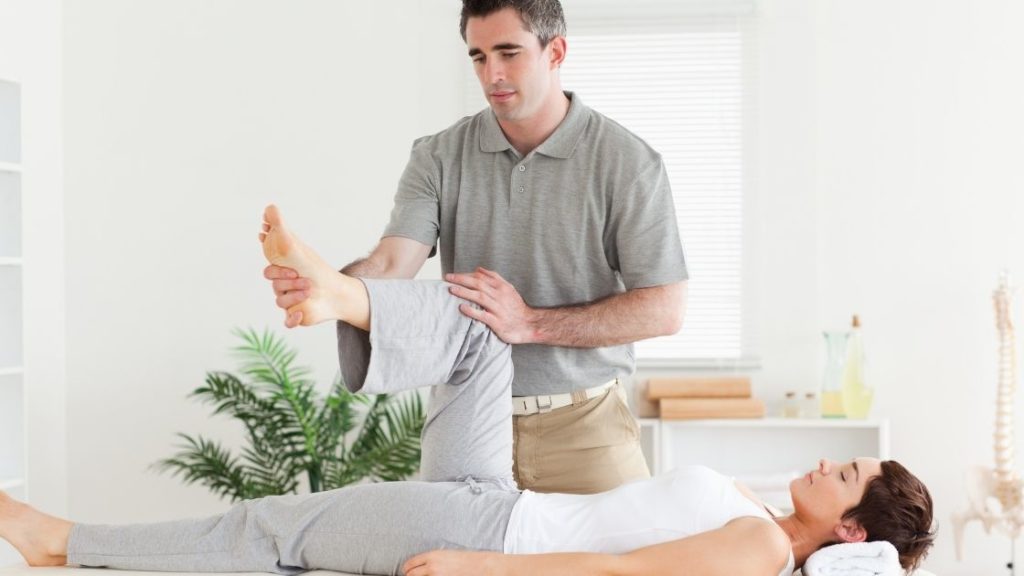What is PNF Stretching?

PNF stretching, or proprioceptive neuromuscular facilitation, is a form of assisted stretching used to improve joint range of motion and physical performance. The modality, with its goal of increasing or restoring one’s flexibility, is often performed by physical therapists, chiropractors, personal trainers, and massage therapists as part of a specialized care plan.
When I use PNF on my own patients, I often describe the instantaneous results as magic. After a single assisted stretch, the person receiving treatment watches their range of motion improve before their own eyes. Now, assuming you’ve never received or watched someone perform PNF, how is the technique executed? How does it work?
How Does PNF Stretching Work?
PNF is a combination of two different types of stretches:
- Passive Stretching
- Isometric Stretching
When you place a muscle group into a stretched position and hold it there for a few seconds, you’re performing a passive stretch; ie. lying on your back and lifting your foot toward the ceiling. When you contract a muscle group without physically moving that muscle group, you’re doing an isometric stretch; ie. placing your forearms against the sides of a doorway and lunging forward for pec stretch.
With PNF, you’ll stretch a muscle group to its limit, and then push that same muscle group against a stationary apparatus. The apparatus in this case is the person, be it a therapist or personal trainer, assisting you. Your muscles will put forth resistance for a few seconds, then you’ll take in a deep breath while relaxing the muscles, and your assister will push your muscle group further as you exhale.
So now you know how it’s done, but how does it instantly improve one’s range of motion?
Stretching a muscle group to its full limit, and then holding that position for a few seconds, triggers an inverse myotatic reflex. An inverse myotatic reflex is a protective response to a prolonged muscle stretch. It signals the muscle to relax itself, in order to prevent tears and strains, when the muscle is pushed a little bit further. Muscles become more pliable when relaxed, which is something I addressed in the When is the Best Time to Stretch article.
Now because a relaxed muscle is a more flexible muscle, PNF exercises tend to be most effective after a muscle is warmed up. A personal trainer may assist with PNF at the end of their trainee’s work out. Massage therapists generally perform PNF after the targeted muscles have been massaged. A health professional might also apply direct heat, with a hot pack or a bodywork modality that produces heat (cross fiber friction, ultrasound therapy, etc.) to facilitate PNF.
Types of PNF Stretches
There are three different types of PNF stretches:
- Contract-Relax Method
- Agonist-Contract Method
- Contract-Relax-Agonist-Contract Method
For brevity’s sake, let’s just call them CR, AC, and CRAC.
CR
Involves contracting, holding, relaxing, and then stretching the targeted muscle group.
AC
Involves static or dynamic contraction of the opposite muscle group prior to stretching the targeted muscles, and is followed by a static or dynamic stretch.
- Static stretch: the holding of a muscle in an extended position for a period of time
- Dynamic stretch: an active movement that brings joints and muscles through their full range of motion
CRAC
A combination of CR and AC. (Sometimes called hold-relax-agonist-contraction.)
Do it Safely!
While you can do PNF stretches on your own, either with a resistance band or another type of stretching device, it really is safest to receive professional assistance. Now here are some helpful tips for a safe PNF session:
Don’t Allow Yourself to Hurt
When you reach your full range of motion, you should feel a little pulling discomfort, but not actual pain. If you experience pain, communicate it to your therapist. Trying to fight through it puts you at risk for further injury.
Be Mindful of Your Breathing
During PNF, your therapist will probably guide you through the breathing. You don’t want to hold your breath too long, as that will deprive your muscles of oxygenated blood. An unnourished muscle is a less flexible muscle.
Try it out!
Make an appointment today and add therapeutic stretching to your session!

Katrina Jenkins
Author, Licensed Massage Therapist
Katrina Jenkins graduated from Towson University in 2013 with a Bachelor’s Degree in Health Science and worked as a nurse’s aide briefly before pursuing her true passion. She graduated from the Massage Therapy Institute of Colorado in April 2016 with honors and completed the Touch of Healers Scholarship Program the following summer. She has been a part of the Moyer Total Wellness Team since the summer of 2017.
Works Cited
Chertoff, Jane. “Dynamic Stretching: Benefits, When to Use, Examples, and More.” Healthline, 23 May 2019, www.healthline.com/health/exercise-fitness/dynamic-stretching#stretches-for-warming-up.
Hindle, Kayla, et al. “Proprioceptive Neuromuscular Facilitation (PNF): Its Mechanisms and Effects on Range of Motion and Muscular Function.” Journal of Human Kinetics, vol. 31, no. 1, 1 Mar. 2012, pp. 105–113, www.ncbi.nlm.nih.gov/pmc/articles/PMC3588663/, 10.2478/v10078-012-0011-y.
Lim, Wootaek. “Optimal Intensity of PNF Stretching: Maintaining the Efficacy of Stretching While Ensuring Its Safety.” Journal of Physical Therapy Science, vol. 30, no. 8, 2018, pp. 1108–1111, 10.1589/jpts.30.1108. Accessed 3 Dec. 2019. https://www.ncbi.nlm.nih.gov/pmc/articles/PMC6110207/
“STRETCHING and FLEXIBILITY – How to Stretch.” Web.mit.edu, web.mit.edu/tkd/stretch/stretching_5.html.
Photo Credit
Canva by Wavebreakmedia
Canva by dima_sidelnikov

